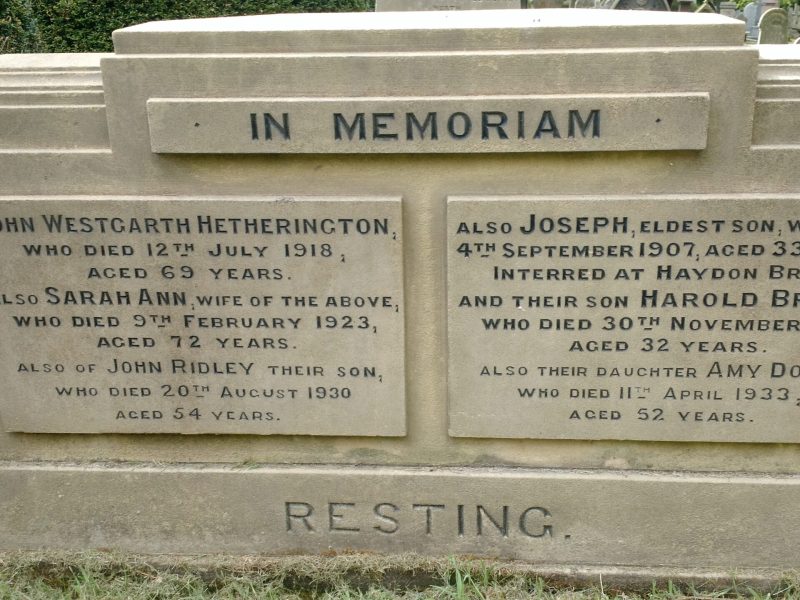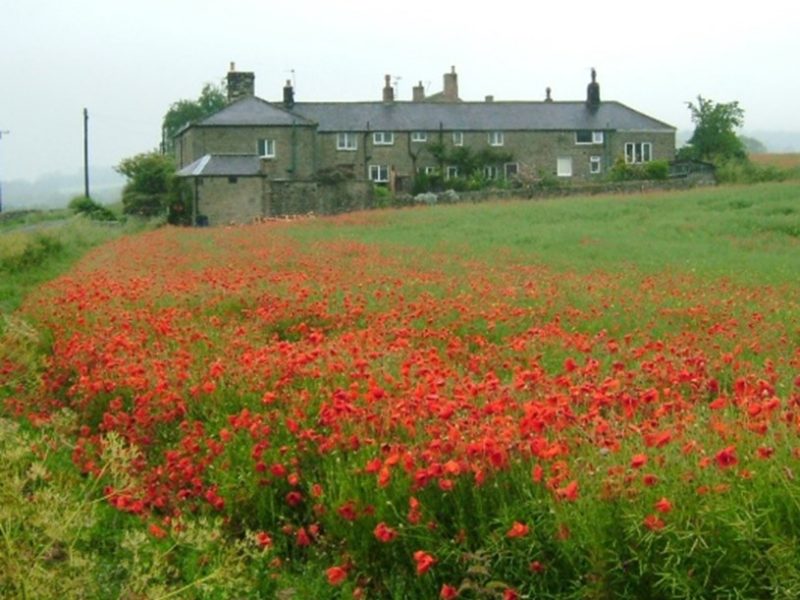LOCAL SOLDIERS LOST DURING THE GREAT WAR

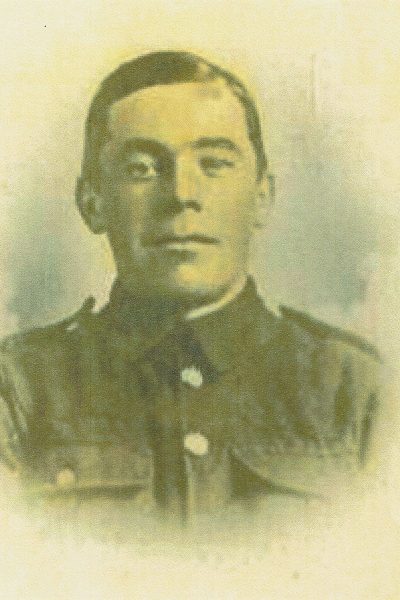
Thomas Norman Davidson
Lance Corporal 919 “C” Company 1/4th Battalion (Territorials)
Northumberland Fusiliers
Norman’s father Tom, had seven children and worked as a lead miner before he ended up a platelayer for North Eastern Railway living at 5, Railway Cottage, Fourstones. Norman was a barytes dresser at Settlingstones Mine when he was 16 years old.
As a member of the Territorials he was called up when war broke out and was posted to France on 20th April 1915 but in less than a week was reported missing in action. He was 20 years old.
The Hexham Courant reported (22nd May 1915) on the Memorial Service at the Primitive Methodist Church, Haydon Bridge and a touching address given by the Rev. G. T. Scott in memory of local soldiers who have given their lives for their King and country in action in the recent severe fighting in Flanders.
Norman Davidson Remembered with Honour Ypres (Menin Gate) Memorial on Newbrough War Memorial, Newbrough Town Hall Great War Roll of Honour and St Peter’s Church Lychgate, Haydon Bridge Memorial, Shaftoe School Memorial, the organ in the Haydon Bridge Methodist Church and T.A. Centre Hexham.
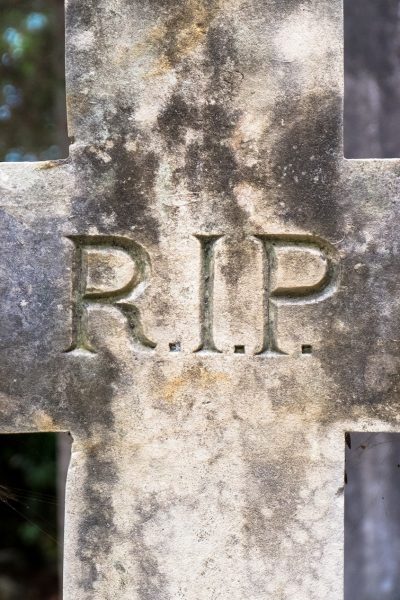
John Henry Bell
Private 17819, "A" Company 1st Battalion,
Sherwood Foresters (Notts and Derby Regiment)
The Commonwealth War Graves Commission remembers with Honour Private J Wellington Regimental Number 17819. This soldier was a former pupil of Newbrough Boys’ School but is not named on any local memorial. In fact this was an alias used by John Henry Bell who is commemorated on St Peter’s Church Lychgate, Newbrough School Memorial Tablet and the Ploegsteert Memorial to the Missing in Belgium.
John born 14th December 1874 and baptised at Hexham Wesleyan Methodist on February 28th 1975 was the third of four sons to Joseph and Mary Bell who lived at Brass Cottages.
He left Newbrough School in 1888 and became employed as a labourer at the colliery, then in Lime Kilns and finally mining barytes at Settlingstones Mine. When war came he enlisted at Worksop, “A” Company 1st Battalion, Sherwood Foresters (Notts and Derby Regiment) and entered the theatre of war on 18th March 1915
The Victory Medal, British War Medal and the 1914-15 Star (WWI Campaign Medals nick-named Pip, Squeak and Wilfred) were sent to his parents when he died in action on 9th May 1915 aged 41 years.
Remembered with Honour Ploegsteert Memorial, Newbrough Town Hall Great War Roll of Honour, Newbrough School Memorial Tablet and St Peter’s Church Lychgate.
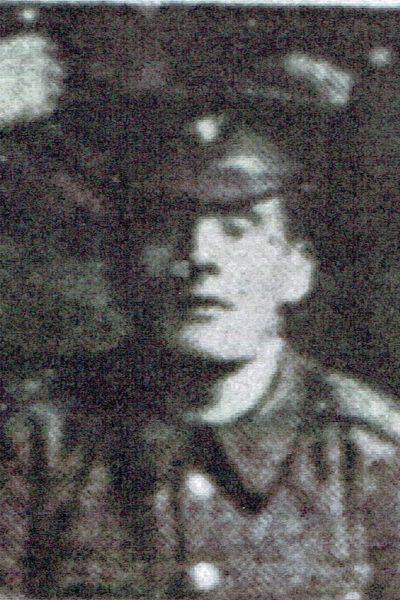
William Hislop,
Private 1698, 1st/4th Battalion Northumberland Fusiliers
William Hislop snr. married Isabella Watson at Bellingham in 1887 and brought up eight children at Park Shields. He was a freestone quarryman and two sons William and John Tom, after they left Newbrough School, worked as putters at Messrs Benson’s pit at Fourstones.
John Tom, two years younger was a private in 4th Battalion Northumberland Fusiliers attached to 103rd Light Trench Mortar Battery. He was wounded at 2nd Ypres on 24th April 1915 and spent some time in hospital in Suffolk. He was injured at the Somme 23rd September 1916 and then again at Arras on Christmas Eve 1917. Both sons appear on the Hexham Territorial Army Roll of Honour
William was a member of “C” Company, 4th Battalion Northumberland Fusiliers having enlisted in August 1914 just after the outbreak of the war. For a brief time he was stationed at Hexham, but after that joined the active service battalion and was with them at the various places they were located till it left Blyth on 20th April for France.
The parents received this letter dated 28th May 1915 – “I very much regret to say that your son, Pte. W. Heslop was killed in action yesterday, and I must convey to you the heartfelt sympathy of all the officers and men of his company. Your son was shot through the head by a rifle bullet and immediately became unconscious, and I do not think he suffered any pain. We buried him at nightfallon the edge of a wood and have marked the place with a cross with his name, number etc., and you will be able to obtain full particulars of the place later. We will also send you some of your son’s personal belongings immediately we are able to do so. Your son was an excellent soldier and most popular with his comrades, all of whom feel most deeply for you in your great loss, – very truly yours, BD Gibson, major, commanding “C” Coy., 1/4th NF.
Remembered with Honour Ypres (Menin Gate) Memorial, on Newbrough War Memorial, Newbrough Town Hall Great War Roll of Honour, Newbrough School Memorial Tablet and St Peter’s Church Lychgate.
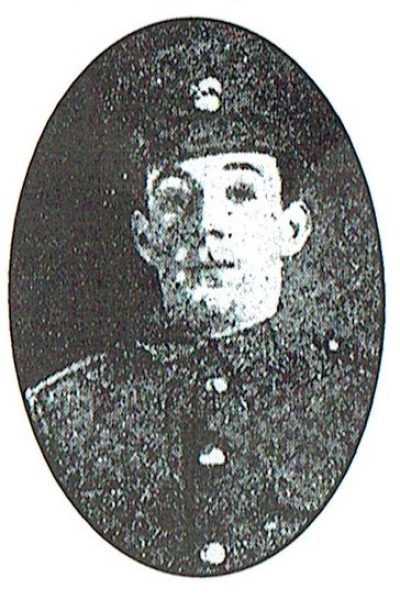
Joseph William Cowen,
Private 2515 1st 4th Battalion Northumberland Fusiliers
Joseph was born in Allensgreen, Bardon Mill in 1894, the eldest son of William and Alice Cowen (nee Herron). The family were agricultural workers and various census records showing the births of the children indicated that the family moved from farm to farm. Some of the places mentioned – Rothbury, Cockplay (Humshaugh), Allgood Farm (Simonburn), Fourstones, Wall, West Wharmley and Styford Barns Farm (Stocksfield).
Joseph enlisted with 1st 4th Battalion Northumberland Fusiliers and disembarkation to France with Territorials took place on 20th April 1915. He was entitled to the Victory Medal, British War Medal and 1914-15 Star.
Joseph was wounded on Whit Monday at the Battle of Bellewaarde (May 1915) and spent many weeks in hospital in Rouen. He died on 8th July 1915 and is buried in St Sever Cemetery, Rouen. The family requested that the Imperial War Graves Commission added the following inscription to his memorial:
“Ever remembered by father, mother, sisters and brother. Rest in Peace”
He is Remembered on Newbrough War Memorial, Newbrough Town Hall Great War Roll of Honour, and St Peter’s Church Lychgate.

Matthew Coulson,
Private 6382 8th Battalion Northumberland Fusiliers
Matthew Coulson was practically first in the district to answer his country’s call to join Kitchener’s Army which he did on 11th August 1914. His father Luke was an engineman and electrician, and with mum Mary Jane and sister May Ellen a nurse, lived in Newbrough Hall Lodge.
He was employed as a clerk in Messrs Benson’s Coal and Lime Office, where he was most highly esteemed. He officiated as organist at St Aidan’s Fourstones and always took an active interest in all Church matters. He was described as an ardent member of the cricket and football clubs at Newbrough and the mainstay of the football club for some time.
Matthew Coulson, Pte. 6382 8th Battalion Northumberland Fusiliers, was killed in action on August 10th in the Dardanelles aged 25 years. A memorial service was held at St Peter’s, Newbrough, on September 12th. He left an estate of £99 3s to his father.
He was entitled to Victory Medal and British War Medal and 15 Star and is commemorated at Helles Memorial Turkey and remembered on Newbrough War Memorial, Newbrough Town Hall Great War Roll of Honour and St Peter’s Church Lychgate.
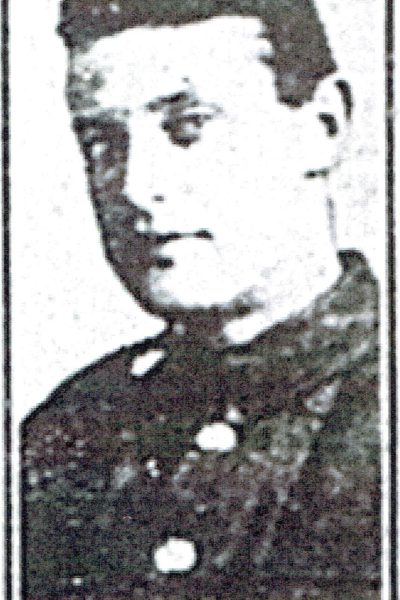
John Wilson Martin,
5067, 8th Battalion, Northumberland Fusiliers
John Wilson Martin was the eldest of six children born to John and Mary Ann Martin (nee Forster); father being an underground coal hewer. The family lived in Fourstones and the four sons worked in the mining industry as shifter, putter, driver and a stone breaker in the quarry.
The 8th Battalion, Northumberland Fusiliers was raised in Newcastle August 1914 as part of Kitchener’s First New Army and John enlisted at Newburn. His battalion was involved in action at Suvia Bay on 6th August 1915 and John’s death was presumed 19th August 1915; he was 26 years old.
He was buried at Gallipoli, Canakkale, Turkey and commemoration by the Imperial War Graves Commission; he is Remembered with Honour Cape Helles Memorial and St.John’s Church Greenside.

William Thomas Butland,
Corporal 44703 91st Field Company Royal Engineers
One can find recorded in the Absent Voters’ List 1918 for the Hexham Division, “John George Butland, Butt Bank, No 14465 Cpl Army pay corps York 2nd Army Pay Office and Robert Edward, Butland School House, DMC/195552 Pte MT ASC 615 MT Coy Dublin HDL.” John is the brother of Newbrough School’s Headmaster and Robert his son. William Thomas and Mary Butland had one other son (William Thomas) and three older daughters.
William Thomas jnr., born in 1895 left Newbrough School in 1906, to become a marine engineering apprentice. He was an undergraduate at Armstrong College, Newcastle-on-Tyne. He enlisted at Newcastle and as a Corporal in the Royal Engineers he saw action in the Western European Theatre for 91st Field Company and on or around 26th September 1915 was considered dead. His father adds that he was wounded at the battle for Hill 70. This was the Battle of Loos, the British Army’s contribution to the major Allied offensive launched simultaneously with the main French offensive in Champagne. It was the “Big Push”.
He is remembered with Honour on Newbrough Town Hall Great War Roll of Honour, Newbrough School Memorial Tablet, Newbrough War Memorial, St Peter’s Church Lychgate and Loos Memorial Loos-en-Gohelle, Departement du Pas-de-Calais.
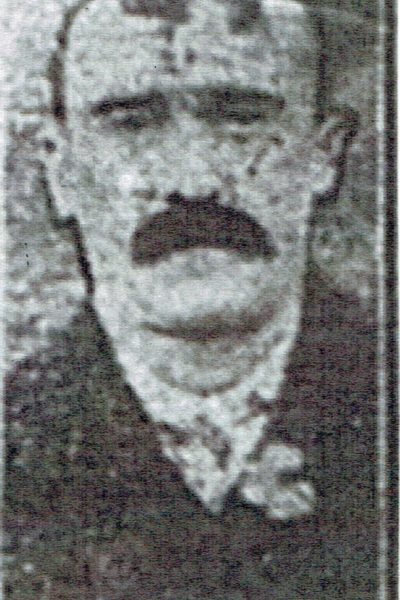
William Watt,
Private 4/2716, 1st/4th Battalion, Northumberland Fusiliers
William has the unenviable distinction of being the oldest fatality in this publication at the age of 46 years. He was born in Warden in 1869 the eldest son of ten children, six boys and four girls. However, his father died aged 44 in 1884. The family lived at Hardhaugh and William snr worked as a paper finisher at the Paper Mill and this occupation was emulated by his son, William. By 1901 he was working for the railways. He enlisted April/May 1915 and went to France in September with “A” Company 4th Battalion Northumberland Fusiliers part of the British Expeditionary Force.
In 1911 William was a bachelor who lived with his two spinster sisters Mary and Elizabeth in Hexham.
Mary received this letter;-
“4th Northumberland Fusiliers British Expeditionary Force February 14th 1916”
Dear Miss Watt,
I am afraid this letter brings very bad news for you. I am sorry to have to inform you that your brother was killed on the night of February 2nd-3rd. Death was instantaneous and he suffered no pain. Your brother was always a good worker, and was never known to grumble, but went about his work cheerfully. He will be missed by all of us, but especially by the men in his platoon. It is difficult to express one’s feelings, but you have our deepest sympathy in your bereavement.
Yours sincerely, David Turner, Captain.”
William is Remembered with Honour Railway Dugouts Burial Ground (Transport Farm) West-Vlaanderen, Belgium. Inscribed on his grave stone;
ON WHOSE SOUL SWEET JESUS HAVE MERCY R.I.P.
He is remembered, War Memorial in Hexham Abbey Grounds, War Memorial Hospital, Eastgate (originally) now Hexham General Hospital and on the Altar Plaque at St Mary’s RC Church Hexham – Requiescant in Pace
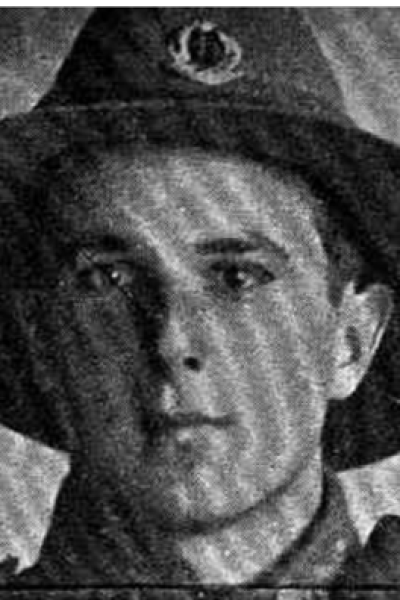
William Gibson,
Private 10226 1st Battalion CIR 12th Company New Zealand Expeditionary Force.
William was born on 21st February in Fourstone and baptised at Warden St Michael on 5th April 1896. He was the first child of George Gibson (Fourstones joiner) and Scottish wife Jane Isabella Low (father was manager at Paper Mill).
The family farmed at West Wharmley (1850s), Newbrough then Fourstones (1901). George, his wife Jane and sons William, Alexander David, Edward Massam, Donald and Arthur emigrated to New Zealand, sailing from London on SS Ionic (Harland and Wolff – White Star Line) to Wellington then landing in New Plymouth 10th August 1910. The family’s farm address was Tynedale , Rahotu (Taranaski) North Island NZ
He was serving in a mounted regiment on the outbreak of war and when the Government asked for volunteers as infantrymen he joined as a private.
Private William Gibson no.10226 enlisted on 13th December 1915 with 1st Battalion CIR 12th Company New Zealand Expeditionary Force. His medical history describes a 20-year-old, 5ft 10 inches tall, weight 140 lbs and having 35 to 38 inch chest. He had a dark complexion, brown eyes, dark hair, teeth fair and was Church of England.
Returning to Europe with the Canterbury Company he contracted sand fever in Egypt. He joined 12th Nelson Regiment Company in France on 8th July and was killed in action on 18th July 1916. He was 20 years old, and the grandson of the late Mr David Low, of Warden Paper Mill.
Remembered with Honour Cite Bonjean Military Cemetery, Armentieres.
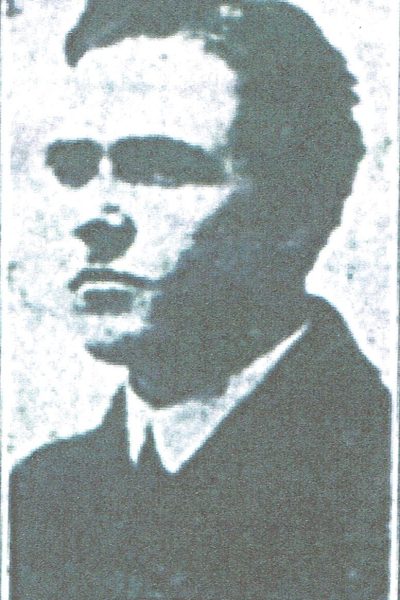
Louis Charlton,
Leading Seaman, Tyneside Z/101, Howe Battalion, Royal Naval Volunteer Reserve
Louis’s parents were Anthony and Anne Charlton (nee Henderson). Sadly his father died when he was eight years old, leaving mum with eight children. He left Newbrough School in 1904, was well-known in both Allendale and Hexham districts, and highly esteemed for his genial disposition and winning ways.
He enlisted in the Royal Navy Division immediately on the outbreak of war with Howe Battalion A/327 and in the February following went to the Dardanelles. He went through all the prolonged fighting in the Gallipoli Peninsula, where he was wounded. Afterwards he suffered from enteric fever, and went to Egypt to recoup. On neither occasion was he sent home. When the Royal Navy Division was transferred to France he came with it, and saw some strenuous fighting on the Western Front.
He was killed instantly but the circumstances of his death were of the most heroic character, as the accompanying letter from his commanding officer shows. The Hexham Courant reported, “The sympathy of all will go out to his sorrowing relatives in their bereavement, but they have the comforting knowledge that he died a noble death.”
Lieutenant Commander P.H. Edwards, writing from France on the 30th August to Mrs Charlton, says:- “I am indeed sorry to have to write to you on such a cruel subject, but I thought it would be a comfort to you to know how nobly your brother Louis died. There was a very fierce bombardment of our trenches and the enemy were dropping very large shells when a sentry was struck, and your brother, without any regard for his own danger, rushed from his shelter and he was killed whilst tending the wounded man. No man could have a nobler death. He was in the same Company with me on the landing, and I have known him and trusted him ever since. When I, as his Company Officer, recommended him for promotion, I told him how I relied on his cheerfulness and kindness to my wounded. His bravery was always taken for granted. I cannot say how I and the whole Company will miss him, but you in your sorrow can be proud of him and the example of unselfish devotion he left to officers and men. You might like to know that he did not suffer much, but knew his wound was fatal and died just peacefully.” He was 29 years old.
Louis is entitled to Victory Medal, British War Medal,1914-15 Star and is remembered with Honour at Tranchee De Mecknes Cemetery, Aix-Noulette and is inscribed on the
Hexham War Memorial, Newbrough School Memorial Tablet and St Peter’s Church Lychgate.
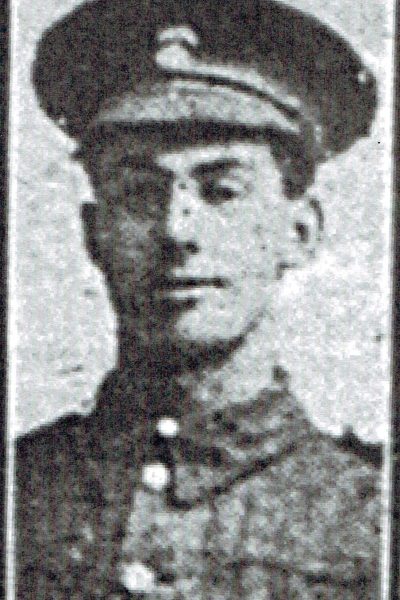
Thomas Sowerby
Lance Corporal 2900, 1st/4th Battalion, Northumberland Fusiliers
Thomas was born in Wiggonby in 1893 the first of six children to John and Susanna Sowerby (nee Robson)
He enlisted at Hexham with Northumberland Fusiliers (Territorials) and was killed in action on 15th Sept 1916 aged 23 years. He was entitled to Victory Medal and British War Medal
The Haydon News publication says of Thomas “always bright and cheerful and liked by all.”
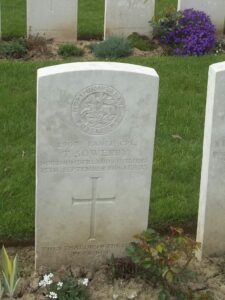 Remembered with Honour Delville Wood Cemetery, Longueval, also Newbrough War Memorial, St Peter’s Lychgate also Haydon Bridge Memorial, Shaftoe School Memorial, Reredos in St Cuthbert’s Church, the organ in the Haydon Bridge Methodist Church.
Remembered with Honour Delville Wood Cemetery, Longueval, also Newbrough War Memorial, St Peter’s Lychgate also Haydon Bridge Memorial, Shaftoe School Memorial, Reredos in St Cuthbert’s Church, the organ in the Haydon Bridge Methodist Church.
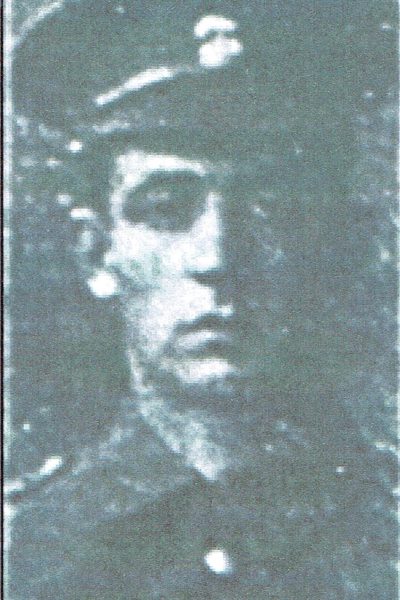
Frank Hodgson,
Private 2788 1st/4th Battalion Northumberland Fusiliers
Frank was a son of Joseph and Margaret Hodgson (nee Young) of Kiln Cottages Fourstones and before entering the army was in the employ of Messrs Wm Benson and Sons Ltd as a coal hewer and Hexham Courant reports that he “was recognised as a very good workman”.
In fact he was one of eleven children (nine survived childhood) and on the 1911 census is described as a “putter” at the colliery. Putters were all boys or youths who filled the corves (strong osier baskets in which the coals are conveyed) and lead them from the hewers; extremely arduous work.
Younger brother Joseph Private 200055 served with 4th Northumberland Fusiliers and 1st Royal Berks. He left Newbrough School in 1905 and became a putter.
On 5th May 1917 the Hexham Courant noted that Mrs Hodgson had received news that her third son Private Thomas Hodgson was in hospital suffering wounds in the neck sustained on August 24th 1916. He was to receive at least two further injuries (26/04/1917 and 24/09/1918) whilst serving as a Private in 9th Northumberland Fusiliers. In the same newspaper report it was stated that Frank Hodgson, Private of Northumberland Fusiliers who was mortally wounded on 18th September died at South Midland Casualty Clearing Station, France.
Remembered with Honour Dernancourt Communal Cemetery Extension, Newbrough War Memorial, Newbrough Town Hall Great War Roll of Honour, Newbrough School Memorial Tablet and St Peter’s Church Lychgate.
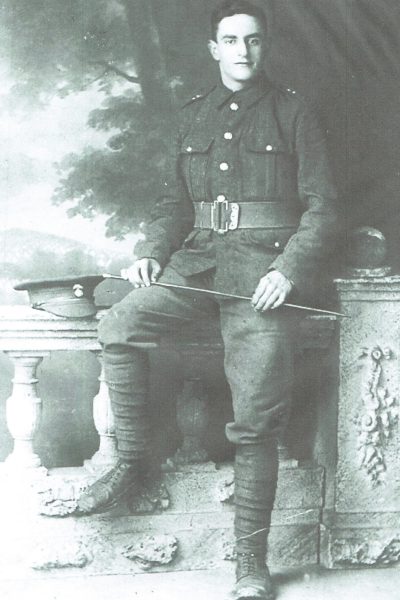
John Stevenson
Private 4142, 8th Battalion Northumberland Fusiliers
Thomas William Stevenson Snr, a limestone quarryman married a Hexham lass Ann Isabella Riley in 1892 and soon after John was born followed by five other children. When John left Newbrough School in 1907 he also became a limestone quarryman. Younger brother Thomas William left Newbrough School in 1909 when the family moved to Ryton: he fought at the Western Front.
John enlisted at Newcastle with 8th Battalion Northumberland Fusiliers and was posted to the Balkans 10th July 1915. He was entitled to Victory Medal and British War Medal and 15-Star. He was involved in the fighting at Zollern and Stuff Redoubts and was officially listed as “Missing” on the Casualty List issued by the War Office 13th November 1916. He had died on 26th September aged 24 years.
Remembered with Honour Thiepval Memorial and the Ryton Memorial.
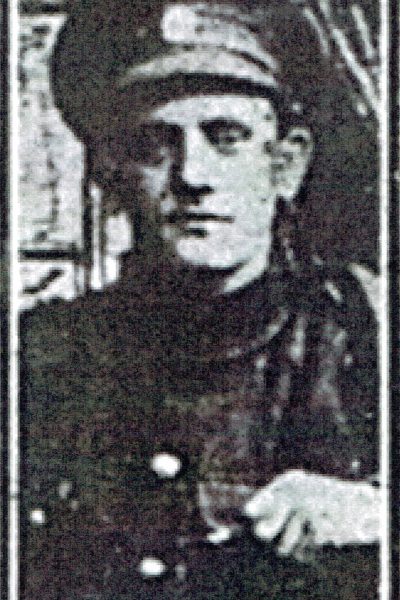
Nicholas Glendinning,
Private M2/054360, Royal Army Service Corps
Nicholas, the father, was a stonemason and lived at Keepershields with his wife Elizabeth (nee Armstrong); their children were John W, Maria H, Margaret M and Nicholas.
Nicholas was the youngest child, born in Slaley early in 1897. The family were living at Stonecroft when Nicholas went to France on 19th April 1915 as a private in the Royal Army Service Corps. He was transferred to 7th Field Army Ambulance Royal Army Medical Corps as a driver. He was entitled to the Victory Medal, the British War Medal and the 1914-15 Star which were sent to his parents when he was killed in action on 10th November 1916, aged 19 years.
Remembered with Honour – Euston Road Cemetery, Colincamps, on Newbrough War Memorial, Newbrough Town Hall Great War Roll of Honour and St Peter’s Church Lychgate.

Henry Anthony Allan,
Private 18742, 15th North Auckland Company Reinforcements of His Majesty’s New Zealand Expeditionary Force
In Dyke Row Cottage (Settlingstones Farm Cottages) Ellen Allan brought up her two children Henry Anthony and Sarah Ann on her own. Mum and daughter worked in domestic service. Henry was born in 1875 and left Newbrough School in 1888 and was soon working as a lead dresser then a freestone quarryman.
He was described as a quarryman when he emigrated to New Zealand in December 1909; a 3rd class passenger on the New Zealand Shipping Company’s SS Tongariro departing from London to Wellington, a journey of 70 days.
In his Soldier’s Will dated 20th February 1917, witnessed by William Riley, he is part of 15th North Auckland Company Reinforcements of His Majesty’s New Zealand Expeditionary Force on active service.
Probate Records of 18th April 1918 detail that he appointed Mrs Harriet Sophia Williamson (wife of WJ Williamson Quarryman) Wolsely Street, Morningside Auckland as executrix and he is reported to have died on or about 21st February 1917 age 41 years. He had £29 4s 3d in a Post Office Savings Bank.
His mum died in 1907 and sister, Sarah Ann, married Robert Lawson in1909 and moved to Castlewellan, Co. Down, Ireland; she was his next of kin.
The Hexham Courant IN MEMORIAM
“Allan. – In loving memory of our dear brother, Henry Anthony Allan, who was killed in action, in France, February 21st 1917. – Ever remembered by his loving sisters.”
The Imperial War Graves Commission’s commemoration – 2nd Auckland Infantry Commune Bois-Grenier, “Y” Farm Militayr Cemetery. He is remembered on Newbrough Town Hall Great War Roll of Honour, Newbrough School Memorial Tablet and St Peter’s Church Lychgate.
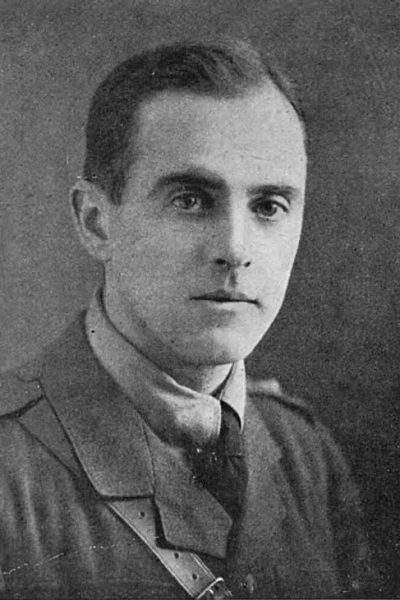
Francis John Graham Leadbitter,
Second Lieutenant 11th Battalion King's Royal Rifle Corps
Francis was the eldest son of Thomas and Matilda Leadbitter of Warden, and was educated at Mostyn House School and Shrewsbury School. At school he was an athlete, gymnast and know as the “Gentleman of the runs”. A rowing cup is named after him and he was a member of a successful Thames Rowing Club VIII. He was admitted as a solicitor in 1904. Four years later he married Teresa Clotilde del Riego and son Jasper Michael was born in 1912. His wife was described as an English violinist, pianist, singer and composer; she wrote the song. “O Dry Those Tears”
Francis joined the Inns of Court Officers Training Corps in December 1915 and obtained a commission one year later. He embarked for France in January 1917.
Late at night on 5th March 1917, whilst the 11th Battalion were relieving the 10th King’s Royal Rifle Corps, Second Lieutenant Leadbitter was shot in the forehead by a sniper.
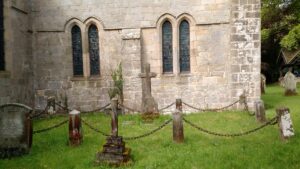 Francis is buried at Guards Cemetery Lesboeufs and his gravestone is inscribed with the following: IN PROUD AND LOVING MEMORY
Francis is buried at Guards Cemetery Lesboeufs and his gravestone is inscribed with the following: IN PROUD AND LOVING MEMORY
He is Commemorated on St Michael’s Warden Plaque inside the Church
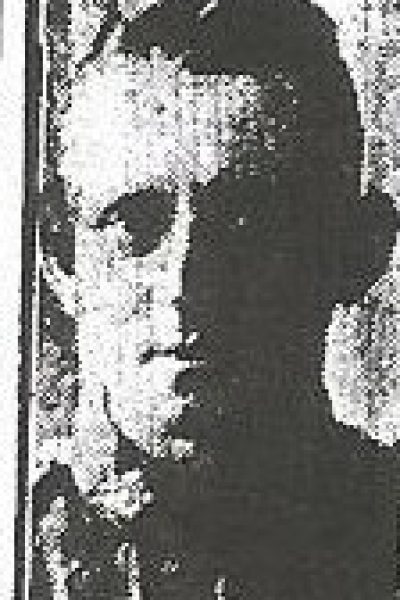
Ernest Walton,
Private 147442, 78th Battalion, Canadian Infantry
Ernest left England in 1913 to go to Canada and was joined later by Mary Jane Balmer who crossed the Atlantic to be married. He enlisted with the Canadians in 1915 and in May 1916 came back to England with his wife. He was christened on 23rd March 1890, lived in Nether Warden and his father, John had a Tailor’s shop in Back Street, Hexham.
He went to France in August 1916 and Fell at Vimy Ridge on Easter Monday; he was 27 years old.
A letter from Major HR Linnell of the Canadians, “Dear Madam,
I am writing to express to you my deepest sympathy in the loss you have sustained by the death of your husband. The one consolation which I can give you is that he died nobly doing his duty. It occurred in the Battle of Vimy Ridge on Easter Monday morning, while we were advancing and driving the Germans back. He is buried on the ridge with numbers of his comrades. I feel his loss very keenly, as do all his comrades. I always found him a splendid soldier, absolutely fearless and his chief aim always to do his duty. He was one of the most popular men in my company and his devotion and loyalty to myself and my officers was splendid. His death occurred very quickly and was quite painless. His last words to me were “Please write and tell my wife”. In fulfilling his last request is the last thing I can do and if there is any way in which I can help you or give you any assistance I should consider it a small return for your husband’s devotion and loyalty to me”.
Vimy Ridge was captured in a frontal bayonet charge against machine-gun positions and became a symbol for the sacrifice of the young Dominion. In 1922, the French government ceded to Canada in perpetuity Vimy Ridge, and the land surrounding it.
Ernest Walton is remembered with Honour on the Vimy Memorial.
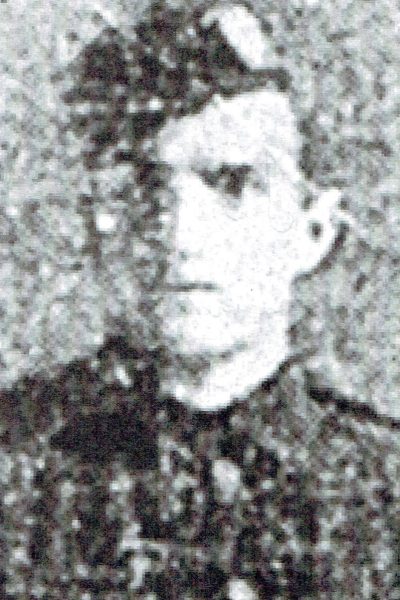
James Hardy,
Corporal 22/1669 22nd Battalion Northumberland Fusiliers (Tyneside Scottish)
James, born at West Boat, was the second son to single mum Mary Hardy and the family also lived in High Wood Farm and Fourstones Village. Mary became deaf in her early twenties but managed the family home which included her sons Hugh and James and her brother Robert.
James joined the Tyneside Scottish in April 1916 and went to France in January 1917.
During April and June the Fusiliers were called upon to launch an attack in support to a larger French offensive of the Scarpe, but the offensive – often known as the Battle of Arras – got bogged down and became an attritional slog Corporal Hardy was reported missing on or since 5th June 1917, presumed dead. He was 22 years old.
He was previously employed at Warden Paper Mill, very well-know in the district and respected by all. His mother received a letter from his Colonel expressing his deepest sympathy with her in her bereavement. James was described as being “an excellent soldier” and his Company Commander had high opinion of him.
His memory is preserved on the Arras Memorial at Faubourg-D´Amiens Cemetery, Arras, and remembered on Newbrough War Memorial, Newbrough Town Hall Great War Roll of Honour and St Peter’s Church Lychgate.

Thomas John Briddock
33827, 3rd Battalion Auckland Regiment, New Zealand Expeditionary Force
Tom was born in 1876 at Papakura Valley, New Zealand of British parents, Joseph and Hannah Briddock who were married at Hexham in 1871. He remained a British Subject.
On 8th April 1917 he was training at Sling camp on Salisbury Plain with the 3rd Auckland Battalion Wellington Regiment of the New Zealand Expeditionary. A letter he sent home on this date was accepted to be his last “will and testament”. His siblings, included Matthew Milburn, Jessie Isabella, Jane Ellen, Joseph, Margaret, John William, George Batey and youngest child Isaac Thompson was a Salvation Officer. Tom wished to see his cousins in Newcastle and the Hexham Courant places him with members of his family at Warden Battock. If so that would have been his last contact with family. On 30th June 1917 Tom died of wounds in France.
Remembered with Honour Wimereux Communal Cemetery, Departement du Pas-de-Calais, Nord-Pas-de-Calais, France

Robert Smith
Private 100197 15th Battalion Durham Light Infantry
Robert was the youngest son of William Smith of Woodbine, Fourstones, a Contractor, by his wife, Mary, daughter of Robert Lumsdon of Bill Quay. He was born in Riding Mill on 31st August 1890 and educated at Newbrough Boys’ School. He left school in 1903 and was employed first as a cartman then a timber haulier
He joined Durham Light Infantry on 13th May 1918, served with the Expeditionary Force in France and Flanders from 7th September 1918. When he was with the 5th Battalion Lewis Gun Section, he was killed in action at Roint, west of Warlencourt on 7th October. He was buried where he fell.
He married Annie Isabella daughter of Robert Benson of Woodbine Cottage. In the Parish of Newbrough St. Peter baptisms are registered for Margaret on 21st January 1916 and Cicely 12th April 1917. (The entry added – Robert Smith (Cartman) and Annie Isabella living at Dyke Row Cottage).
A year after his death his family, in the Hexham Courant In Memoriam, published these words,
One year has passed and none can tell,
The miss of one we loved so well;
But while he lies in peaceful sleep,
His memory we will always keep.
Ever remembered by his loving wife and two little daughters – RIP
Remembered with Honour Vis-En-Artois Memorial He is remembered on Newbrough Town Hall Great War Roll of Honour, Newbrough School Memorial Tablet and St Peter’s Church Lychgate.
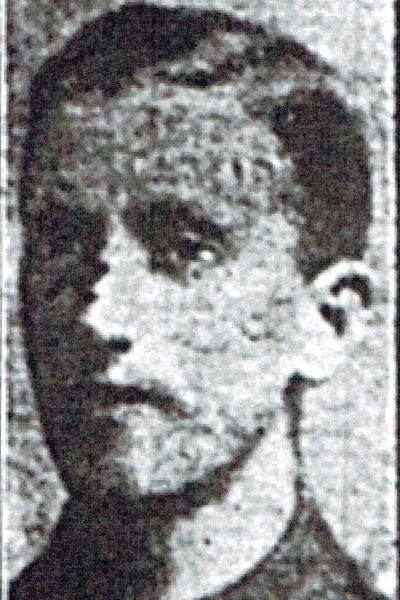
Matthew Henry Lowes,
Lance Sergeant 34155, 24th (Tyneside Irish) Battalion, Northumberland Fusiliers
Matthew and Mary Jane Lowes (nee Thew) brought up two daughters and three sons at Allerwash Mill, and had addresses – Coop Store Cottages, Crossgate Cottages, Broadfield and Butt Bank Cottages. Matthew senior died in winter 1915.
The youngest son George Richardson, Private 50782, 6th Lancashire Fusiliers fought on the Western Front and took part in the Big Push. He was a prisoner in Germany for eight months. Edwin John, Private, 235422 2/4th London Regiment and Northern Cyclist Corps fought on the Western Front and was wounded at Passchendaele
Matthew Henry’s baptism (as well as his two brothers) can be found in the Register Newbrough St Peters 2nd November 1890; father Matthew described as a labourer living at Allerwash Mill. All three sons attended Newbrough School.
Matthew was employed as a banksman at Fourstones Colliery and being a member of Territorial Army, when they were mobilised, he was called up. He served some time as a musketry instructor in Newsham district.
He fought at Ypres and Peronne. Mathew died of pneumonia in hospital in France on 31st July 1917 and his next kin were sisters Mrs Ethel H Bestford and Margaret A Lowes.
As a result of meritorious service, he was recommended for a commission.
Remembered with Honour Tincourt New British Cemetery, Newbrough War Memorial, Newbrough Town Hall Great War Roll of Honour, Newbrough School Memorial Tablet and St Peter’s Church Lychgate.
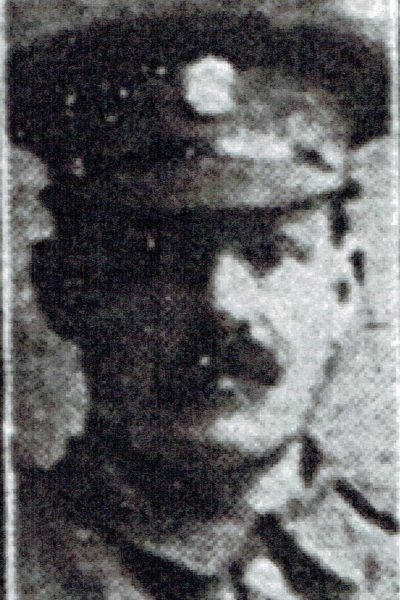
Thomas Wilson
Private 43670 25th (Tyneside Irish) Battalion Northumberland Fusiliers
Thomas Wilson Snr married Elizabeth Natrass and had four children, two boys and two girls. Thomas was born in early 1879 and his father was a labourer in the freestone quarry who lived at Frankham Cottages. After leaving Newbrough School in 1892 Thomas worked as a carter on a farm. As Private 268276 he served with 26th Battalion Northumberland Fusiliers before being transferred to 25th (Tyneside Irish) Battalion.
The Commonwealth War Graves Commission reports his death on 2nd September 1917. He was killed in action on the Western European Theatre at the age of 39 years and he is buried in Hargicourt Cemetery, near Peronne.
Thomas is Remembered with Honour Hargicourt British Cemetery, Ireland’s Memorial Records, Newbrough War Memorial, Newbrough Town Hall Great War Roll of Honour, Newbrough School Memorial Tablet and St Peter’s Church Lychgate.
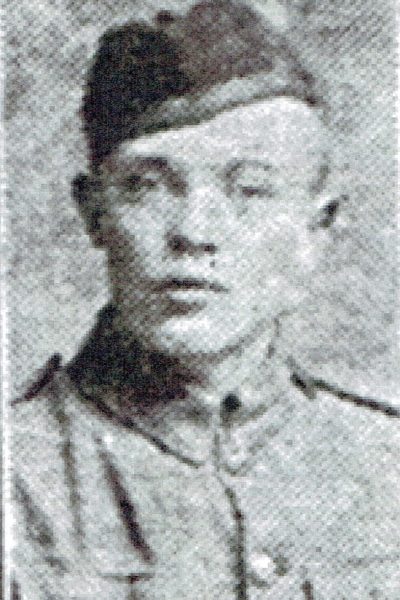
Forster Johnson,
Pte 203480, 1st/4th Battalion, King's Own Yorkshire Light Infantry
Forster was the youngest of seven children born to John and Isabella Johnson (nee Mitchell) at Frankham High Houses and the parish register Warden St Michael 13th March 1898 records Forster’s baptism. The 1901 Census describes the family; father John a platelayer in the freestone quarry, eldest son Frank freestone quarryman, William a steam stone cutter driver, James a freestone quarryman, John a horse driver in freestone quarry; then Forster aged 3 years. The parents with William, Thomas and Forster had moved to St Aidan’s by 1911, and the rest of the family to Ryton Woodside.
James, born in Acomb, left Newbrough School in 1893 became a freestone quarryman and in 1911 a coal miner in Crawcrook. He was a private in 2nd Tyneside Scottish and was wounded at the Somme on 1st July 1916.
Forster enlisted at Hexham, Private 29/138, Northumberland Fusiliers and was transferred to 1st/4th Battalion, King’s Own Yorkshire Light Infantry. His parents and family received various communications from the War Office. On August 11th they received official word that he was “wounded”, on September 2nd that he was “gassed”. On September 17th that he was “missing”. However during that period Foster had been sending letters home indicating that he was not wounded or missing. At the request of the parents the War Office was asked for an explanation, and they replied on October 13th that they much regretted the unnecessary pain and anxiety had been caused to the relatives by the incorrect reports. On the same day the York Records Office had been notified by the War Office that this soldier had died of wounds. As this date was coincidental with the apology and the notification of death emanating from the War Office there was therefore further doubt.
In fact Private Johnson was admitted to No.3 Australian Casualty Clearing Station on 9th October suffering from shrapnel wounds to the abdomen and left arm, and died there on the next day. The sister-in-charge of the hospital wrote, “I am writing to tell you about your son, 203480, Pte. Forster Johnson, K.O.Y.L.I. He was brought into this hospital on the 9th October, suffering from severe wounds in the abdomen. He was operated on immediately, and they discovered that his bowels were perforated in several places and the injury done was very severe. Everything possible was done to relieve him, but he did not pick up at all, and died at 11 o’clock next day. I am afraid that it is very little to tell you, but it might be some comfort to you to know that he was in hospital where he received every possible care and attention, and that he was relieved of all his pain. He was buried next day in a Military Cemetery. – Yours faithfully, Ida O’Dwyer, Sister-in-Charge”
Remembered with Honour Nine Elms British Cemetery, Newbrough War Memorial, Newbrough Town Hall Great War Roll of Honour, Newbrough School Memorial Tablet and St Peter’s Church Lychgate.
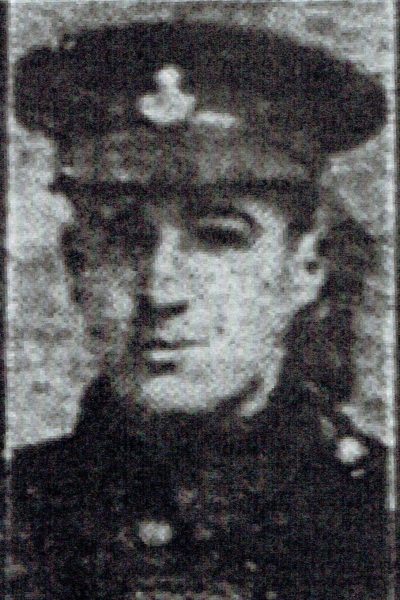
Alfred Cawkwell MM,
Private 44286 26th Machine Gun Company 9th Division
Thomas Herbert and Ellen Cawkwell, on 2nd February 1896 celebrated their son Alfred’s baptism at the Parish Church of Newbrough St Peter. Alfred, oldest of eleven children was born at Greyside but spent much of his youth with his uncle Alfred Williamson in Horwich, Lancashire before returning to work as a labourer at the barytes mine at Settlingstones.
He signed his attestation papers on 11th January 1916 at Newcastle and became a member of Durham Light Infantry, trained at Rugeley Camp then transferred to Private 44286, of 26th Company, Machine Gun Corps (Infantry).
Mrs Cawkwell received notification that her son had won the Military Medal but the writer of the letter was unaware that Alfred had by then been killed.
“Dear Mrs Cawkwell, – Just a few lines to let you know that I was M.G.C in charge of the team that your son, Pte. Cawkwell was wounded with, and I am prepared to say that no one knew a better or steadier lad, in fact I have never met a pluckier lad, and I am proud to know that I had such as he under me. You may perhaps have learned by this time that he has won the Military Medal, and I may say that no one is more worthy of that coveted distinction than he. He got wounded in the leg first of all, and was asked to hand over the gun and get back to the dressing station, but instead of doing so, he still carried on until wounded the second time in the head, which I had the honour and pleasure of dressing for him. I hope by this time that you have heard from him, and that he is keeping well and is progressing favourably. I am extremely sorry for not notifying you sooner of his honour, but I have only just succeeded in obtaining his home address and so have snatched the first opportunity of writing to you. If you are desirous of writing and letting us lads know how he is progressing you can do so by writing to me. I can tell you the lads cannot contain themselves waiting to hear how he is keeping. I must close now, as I want to catch the post, so will finish with my heartiest congratulations. I remain, your sincere friend, Corporal J. Watson.”
His Company was involved in the First Battle of Passchendaele and official reports state he died on or since 12th October 1917 age 21years.
He was entitled to Victory Medal and British War Medal and the conferment of the Military Medal was announced in the 1382 Supplement to the London Gazette on 28th January 1918. After the Newbrough Memorial was unveiled it was noticed that entitlement of having MM after his name had been omitted; this was quickly rectified.
Alfred is Remembered with Honour on the Tyne Cot Memorial Commemorated in perpetuity by the Commonwealth War Graves Commission, Newbrough War Memorial, Newbrough Town Hall Great War Roll of Honour and St Peter’s Church Lychgate.
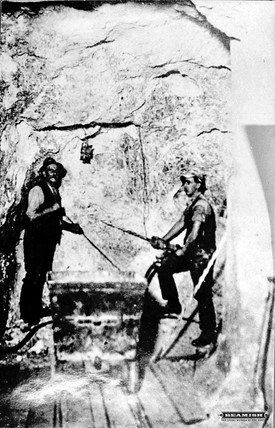 Photo from Beamish Museum Collection
Photo from Beamish Museum Collection
Alfred’s father Tom Cawkwell (left) and brother Harold drilling in fore end, Settlingstones Mine. Settlingstones Mine was opened in around 1690, originally a lead producing mine but in its later years became one of the world’s largest witherite producing mines. It finally closed in 1969 with the vertical seams of witherite having been mostly worked out.
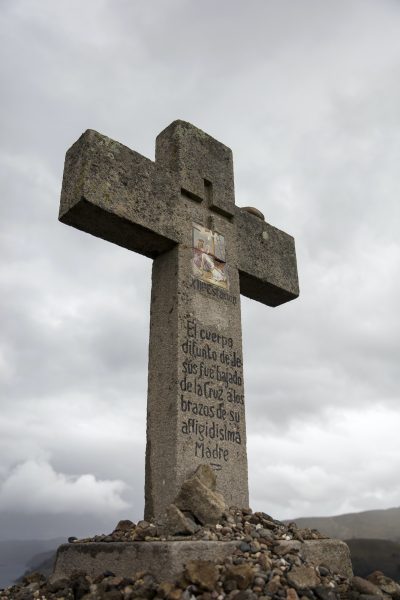
Robert Elliott,
Sapper 1991, 2nd/1st (Northumberland) Field Company, Royal Engineers
Robert was the son of Henry and Annie Elliott, and the family of five children lived at Greyside Farm Cottages. He left Newbrough School (1897) to be an apprentice joiner, so it was not surprising that he when he enlisted (February 1915) it was in the Royal Engineers.
He married Meggie Hudspith from Haltwhistle in 1909 and moved to Hexham to follow his trade as a joiner and later to Stagshaw Lodge.
He served in Loos, Egypt and Salonika. He was reported as missing at Cubuluk Bridge in Macedonia on 2nd November 1916 and is buried there. The Victory Medal, British War Medal and the 1914-15 Star (WWI Campaign Medals nick-named Pip, Squeak and Wilfred) were sent to his next of kin he was 34 years old.
Meggie was left a widow with two children, Annie aged five and George Henry aged 3 years.
Robert Elliott is Remembered with Honour Struma Military Cemetery, on Newbrough Town Hall Great War Roll of Honour, Newbrough School Memorial Tablet and St Peter’s Church Lychgate. Hexham War Memorial. Roll of Honour Hexham Abbey, Hexham Memorial and at Hexham General Hospital (Originally at War Memorial Hospital Eastgate)
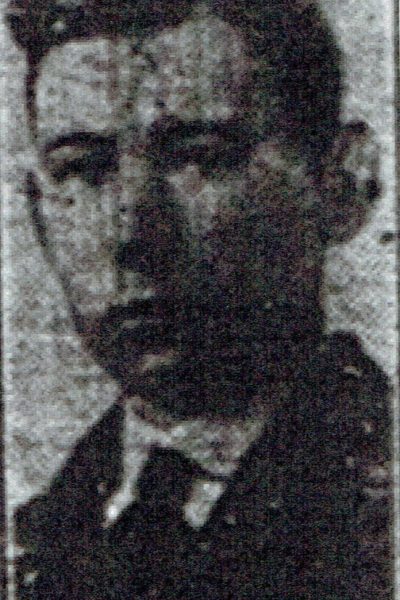
Gladstone Elliot,
Private 40656, 1st Battalion, Northamptonshire Regiment
Henry Elliot was a shepherd at Wolsingham and pursued that occupation in Hexhamshire and Settlingstones. He married Mary Amy Turnbull and she gave birth to eight children. It was at Greyside he became a motor waggon driver at the barytes mine and a number of the family also worked there. Gladstone was their youngest child, born on 29th May 1890 and left Newbrough Boys’s School in 1912. He enlisted on 17th January 1917 and served with the British Expeditionary Force in France died 24th November 1917 of wounds received the previous day. Commonwealth War Graves Commission remembers, “Gladstone, son of Henry Elliot, of Frankham, Fourstones-on-Tyne, Northumberland, and the late Mary Amy Elliot.” His mother had died a year earlier.
Two brothers served with the colours. Roger Turnbull Elliot left Newbrough School in 1903. He was a private with 3rd Northumberland Fusiliers, Home service.
John Henry left Newbrough school in 1908. He was a Corporal, 4th Northumberland Fusiliers on Western Front. He was wounded at 2nd Ypres on 26th April 1915.
Gladstone is Remembered with Honour Dozinghem Military Cemetery, on Newbrough War Memorial, Newbrough Town Hall Great War Roll of Honour, Newbrough School Memorial Tablet and St Peter’s Church Lychgate.
George Spraggon, Guardsman 27331 2nd Battalion Grenadier Guards
George was baptised on 28th September 1879 at Lowick and was the youngest son of William and Alice Spraggon (nee Murdie). He was educated at Ford Village School and in Haltwhistle.
He married Elizabeth Jane Violet (née Browell) at Haltwhistle Parish Church in July 1903 and was the father of three daughters and a son. The youngest, Alister Charles, would never see father. Before the war the family lived at Laverick Cottage, High Warden and George like his father worked as a gamekeeper.
He enlisted on 11th October 1916 and served with the Expeditionary Force in France from 7th April. He died of wounds received at Cambrai, at No. 5 Casualty Clearing Station, 2nd December 1917.
Remembered with Honour Tincourt New British Cemetery. He is remembered on Newbrough War Memorial, Newbrough Town Hall Great War Roll of Honour, St Peter’s Church Lychgate and an Inscription on Cupboard at St Michael and All Saints’ Church Warden.

Arthur Charlton,
Private 200654, 1st Battalion Northumberland Fusiliers
Anne Rachel Charlton brought up her two children (Jane and Arthur) at her brother William Charlton’s farm at Lane House Torney’s Fell. Arthur’s baptism is recorded on 2nd June 1895 in the Parish Register of Newbrough St Peter. He left Newbrough School in 1909 to work as a cowboy on his uncle Christopher Charlton’s Farm on Humshaugh Fell. He enlisted at Hexham and was entitled to the Victory Medal and the British War Medal and was killed in action on 12th December 1917 aged 22 years.
The Commonwealth War Graves Commission’s commemoration is at Mory Abbey Military Cemetery Mory, Departement du Pas-de-Calais. He is also remembered on Newbrough War Memorial, Newbrough Town Hall Great War Roll of Honour, Newbrough School Memorial Tablet and St Peter’s Church Lychgate.
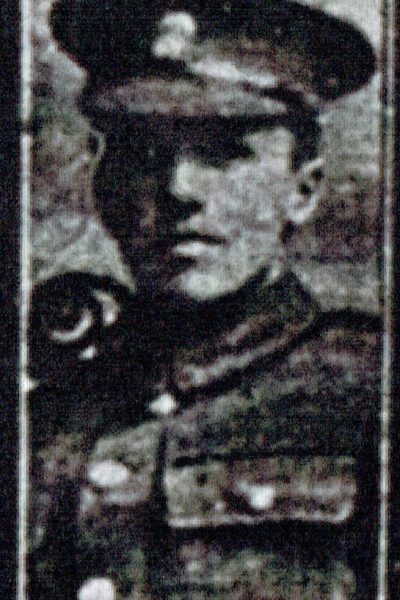
James Beattie
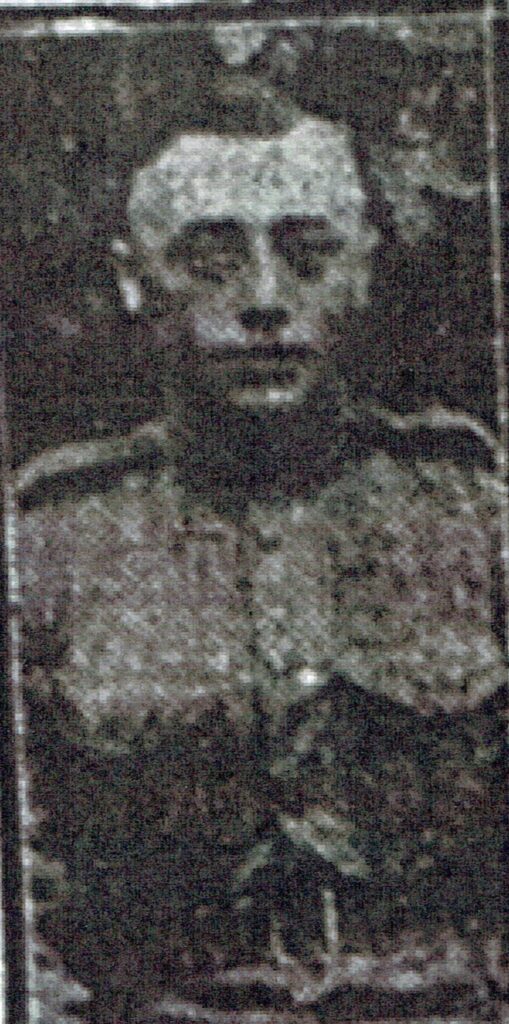
William Beattie
James Adam Beattie,
Sergeant 200696 2nd/4th Northumberland Fusiliers (Territorials)
On July 16th 1893 James Adam Beattie was baptised and his brother Arthur baptised 16th December 1895, both at Warden St Michael and All Saints. Their parents Adam and Mary Ellen (nee Hutchinson) Beattie had two other sons William (born 1889) and George (born 1898). Their only daughter, Agnes Mary, was born in 1887. She, in turn gave birth to a daughter Olive who was baptised at St Aidan’s in 1910. In 1891 they were living at Walwick Grange and father was an agricultural labourer.
William Beattie, Private M2/115789 Motor Transport, Army Service Corps was attached to 21st Field Ambulance, Army Medical Corps. He returned home from Canada, “like many other patriotic boys” and joined the colours in July 1915, leaving Hexham for France as driver of Dr Stewart’s Ambulance Car, “The North Tyne”.
In December 1917 he was transferred to Italy where he suffered from pneumonia and died aged 29 years on 2nd October 1918.
Colonel WJ Wright ADMS Italy on October 6th wrote to William’s mother:
“Dear Mrs Beattie,
With deepest regret I heard of your son’s death yesterday. As his late commanding officer please accept my deepest sympathy in your very sad bereavement During the time I commanded the First field ambulance I always found him most dutiful and cheerful, no work was too hard or too dangerous for him, he always took his orders with a smiling face and in every possible way he was ready to help the sick and wounded. Although I have left my own unit I know well how much he will be missed, both by officers and men with whom he was most popular. He always set a fine example to all ranks and was a splendid example of a true Britisher.”
For his commitment to his work, William had been mentioned in despatches. In December 1917, he was transferred to Italy. He contracted pneumonia and died in 39 Casualty Clearing Station. He is buried at Montecchio Precalcino Communal Cemetery Extension, Italy.
Arthur Beattie Private 523778 Labour Corps – Hexham Courant reported in October 1916 that his parents had been informed that he was wounded.
Brother George Edward of 23rd Northumberland Fusiliers, a prisoner of the Germans, was described by them as “unverwundet” (unhurt) at Parchim Prisoner of War Camp dated 21st May 1918.
James Adam Beattie a farm worker was Acting Sergeant 200696 2nd/4th Northumberland Fusiliers when he gained the British Medal and Victory Medal. He was attached to 3rd/2nd Battalion King’s African Rifles and died of wounds when homeward bound from East Africa on 14th December 1917. He was 24 years of age and he was buried at sea. James is Commemorated at Mombasa British Memorial Kenya
Both William and James are remembered on family gravestone and Plaque at St Peter’s Church, Humshaugh Methodist Church and Roadside Obelisk, Humshaugh.

John James McCready
Private 33926, 21st (Tyneside Scottish) Battalion, Northumberland Fusiliers
James and Rosanna McCready (nee Cunningham) baptised their son John James on 11th April 1885, one of five children. The family lived at Tile Sheds, Nuns Bush then Red Houses and father James was a lime drawer and John, after leaving Newbrough School in 1900, worked in the limestone quarry as a labourer.
The oldest son Henry was Private 308424 Labour Corps and he and younger brother Private John James McCready were both recipients of the British War Medal and Victory Medal.
John served in the Western European Theatre being attached to Durham light Infantry, 5th Labour Company (Infantry) 63338, 36th Labour. Corps. 21288, 21st Northumberland Fusiliers 33926. He was 34 years old when he was killed in action on 19th January 1918.
He is remembered St. Martin Calvaire British Cemetery, St. Martin-Sur-Cojeul, Newbrough War Memorial, Newbrough Town Hall Great War Roll of Honour, Newbrough School Memorial Tablet and St Peter’s Church Lychgate.

Joseph Shield
Lance Corporal 552948, 8th Battalion Canadian Infantry
Thomas William Shield lived in quite a number of places. He was born at Rookhope and in 1891 he’s at Catton (leadore miner), then Whitfield, in 1901 Gunnerton (timberyard labourer),1911 Allendale (rock driller barytes mine) and finally Ardenville Alberta, Canada (possibly a farmer)
Thomas, born in 1870, married Mary Jane Little at Hexham in 1894, had four children who survived childhood. They were John Martin, Joseph, Mary Jane and Thomas William.
John Martin and Joseph attended Newbrough Boys’ School and left in 1910 when they moved to Church Lands at Allendale. The family emigrated to Canada in 1912 (Mary Hannah may not have emigrated) and their new home was in Macleod District, Alberta.
Both John and Joseph joined the Canadian Over-Seas Expeditionary Force. John’s attestation at Pincher Creek on 6th February 1915 describes him as born 18th May 1886, religion – Wesleyan, aged 19 years 6 moths and occupation a farmer. John Martin Shield, Trooper 118096 served with the 13th Regiment Canadian Mounted Rifles.
Joseph’s attestation on 27th March 1916 at Macleod, describes him as born on 22nd January 1898 at Carr’s Mill Whitfield, religion – Methodist, aged 18 years 2 months and occupation a farmer.
Joseph Shield, Lance Corporal 552948, served with the 8th Battalion Canadian Infantry (Manitoba Regiment) died on the battlefield on the 24th January 1918
Remembered with Honour – Mazingarbe Communal Cemetery Extension, Canadian Virtual War Memorial, Canadian First World War Book of Remembrance and St Peter’s Church Lychgate, Newbrough.

Joseph Shield John William Mews
Private 37352, 23rd (Tyneside Scottish) Battalion, Northumberland Fusiliers
John Edward Mews married Sarah Jane Balmer in 1889 and parented four children; three boys, one girl. Brothers, John William and Robert Richard, born and brought up at Low Warden, left Newbrough School to work with horses; Robert on a farm and John a driver at the lime kilns.
Younger brother Robert served in Home service as a private in the 4th Battalion the Yorkshire Regiment at Hornsea. John enlisted with 1/4th Northumberland Fusiliers, was transferred to 20th Battalion, then 23rd (Tyneside Scottish) Battalion with whom he was with when he was reported killed in action on 20th March 1918, aged 27 years.
Remembered with Honour Arras Memorial and Newbrough War Memorial, Newbrough Town Hall Great War Roll of Honour, Newbrough School Memorial Tablet and St Peter’s Church Lychgate.
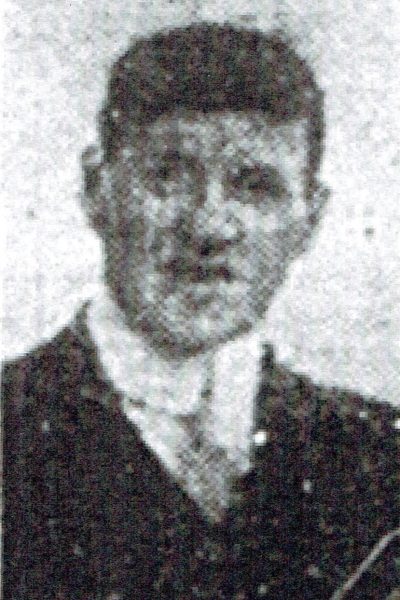
John Cleminson,
Trooper 270758 (1645) 1st/1st Northumberland Hussars
George John (Freestone Quarryman) and Hannah Cleminson, of Crossgate Cottages (Butt Bank Cottages), brought up seven children. John the middle child, left Newbrough School in 1905, and was at one time a groom with Mr WJ Benson at Newbrough Hall then at Stelling Hall.
John joined the Household Cavalry and Cavalry of the Line with 1st/1st Northumberland Hussars and was entitled to the Victory Medal and British War Medal. Two brothers also served with the colours.
Robert left Newbrough School in 1899, a putter in the mine, enlisted at Gosforth Park 13th October 1914, Trooper 270450 with Northumberland Hussars Imperial Yeomanry, (then 235564 9th Northumberland Fusiliers), He was diagnosed with “heart trouble” as a result of trench fever in December 1917; he was wounded at Ypres on 11th April 1918 and spent time in hospital in Scarborough. He served for 4 years and 102 days.
Thomas was a Trooper 267373 with Northumberland Hussars Imperial Yeomanry and Private 6th Northumberland Fusiliers (Also Regimental numbers 4/8173, 6/7918). He left Newbrough School in 1909 was a pony driver who enlisted 18th January 1916, was wounded at Arras on 15th April 1917 and discharged wounded 12th November 1917.
Captain WW Burton, commanding John’s squadron wrote to his father, “I am very sorry to inform you that your son Pte. Cleminson, J. No. 270758 was killed in action on the night of the 22nd. I know that by now you will have received official information. Your son was with the Hotchkiss guns when he was killed. I am writing to express my deepest sympathy in your great loss. He was a fine, quiet lad, and is a great loss to the squadron. The officers of the squadron and myself offer you our deepest sympathy.”
John is Remembered with Honour Pozieres Memorial and on Newbrough War Memorial, Newbrough Town Hall Great War Roll of Honour, Newbrough School Memorial Tablet and St Peter’s Church Lychgate.
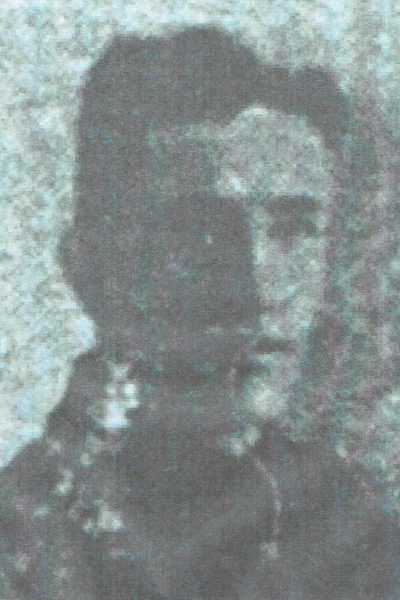
Fred Tiffin
Private 201032, 1st/6th Battalion Northumberland Fusiliers
Grandfather Joseph born in Brampton and judging from census returns and children’s birth places, the family regularly moved around from farm to farm. Those mentioned include Whitinstall, Dissington, Peppy, Bearl, Shafto, Newburn, Longbenton, Bradley Lemmington. In 1901 the extended family lived at Thornton Towers and two grandchildren Fred and Norman attended Newbrough Boys’ School. These boys left school in 1905 when the family moved to Willimoteswick. Their mother Mary Jane Tiffin worked as a general domestic servant at Benwell Hill Farm in 1891 and worked in service at Allerwash Village in 1911 and Wylam Hill Farm in1918.
The boys’ uncle George married Jesse Scott from Fourstones and raised a family at Keepwick Farm. Uncle Robert, a cartman at the colliery. married Mary Ann Brown from Newbrough and two children were born in Kiln Cottages.
Norman enlisted on 24th April 1916 at Newcastle Barracks. He served as Private 241791 Highland Light Infantry (2nd/6th then 1st/9th) and later gained the Victory and British War Medal with the Labour Corps. He served at the Western Front and was wounded on 29th September 1917, 14th April 1918 and on Christmas Day 1918.
Frederick was born at Bradley (near Medomsley) at the beginning of autumn 1894. When he served the colours it was as Private 201032, 1st/4th then 16th then 1st/6th Battalion Northumberland Fusiliers. (His regimental number is among a series of the 6 figure numbers issued to the 4th Northumberland Fusiliers in April 1917. It is quite an early number)
From the 9th April to 29th April 1918 his regimen were involved in the Battles of the Lys. 1918. The third German offensive “Operation Georgette” took place in Flanders with the objective of capturing key railway and supply roads and cutting off British Second Army at Ypres. After initial successes the German attack was once again held after British and French reserves were somehow found and deployed. It is possible Fred was part of the Battle of Estaires, 9th to 11th April 1918. He is officially recorded as killed in action on 11th April.
Remembered with Honour Ploegsteert Memorial the Newbrough School Memorial Tablet and St Peter’s Church Lychgate.

William Lawrence McWilliams MM,
Lance Corporal 200998, 1st/5th Battalion, Durham Light Infantry
John McWilliams and his wife Mary (Nee Hagan from Tyrone) left Ireland around 1866 with three children. Catherine, the fourth of a further eight children, was born in Warden. Kate’s son William Lawrence McWilliams born in Prudhamstone Cottages was christened on 23rd February 1889.
On census returns he is described as a miner coal hewer and he married Mary Jane March in 1911; she was twenty-four years his senior.
Whilst serving as Lance Corporal 200998, 1st/5th Battalion, Lewis Gun Section, Durham Light Infantry the Military Medal was awarded to William for acts of gallantry and devotion to duty under fire. Conferment of the medal was announced in the London Gazette Page 10129 on 27th August 1918.
William was reported missing on 11th April 1918 and presumed died on that date. He was 29 years of age. He is remembered with Honour on the Ploegsteert Memorial, the Lychgate of St Peter’s Church and at Hamsterley Colliery (Christ Church Plaque)

Nicholas Waugh Nicholson
Private 139215, 31st Battalion Machine Gun Corps (Infantry)
For several decades and generations the Nicholsons worked in mines and quarries in the Newbrough area. John a barytes dresser married Margaret Waugh in 1893 and they lived in North Street, Newbrough. Nicholas Waugh, (three brothers two sisters), third of six children was born in 1898 and left Newbrough School in 1912. After enlisting he served as Private 28948, East Yorkshire Regiment then he was transferred to Private 139215, 31st Battalion Machine Gun Corps (Infantry). Serving at the Western European Theatre Nicholas was reported missing, and “death accepted 13/4/1918” at the age of 19 years.
Remembered with Honour Outtersteene Communal Cemetery Extension, Bailleul. He is also remembered on Newbrough War Memorial, Newbrough Town Hall Great War Roll of Honour, Newbrough School Memorial Tablet and St Peter’s Church Lychgate.

William Ernest Hoggard,
Private 30322 1st Battalion Grenadier Guards
William, the eldest son of Charles and Frances Jane Hoggard (nee Fawcett) was baptised in Harrogate on 1st April 1888. The 1901 census records his occupation as a dairyman in Knaresborough where he married Ada Cooke in late 1913 The family moved to 6 Moss Cottages, Warden. Their daughter Frances Winifred’s birth was registered at Hexham in 1915. Father Charles worked for the railways, as a shunter, porter then a NE railway guard. William also worked for the North Eastern Railway as a porter at Fourstone Station before he joined the army in December 1915. William initially was posted to the Household Battalion of the Grenadier Guards, in July 1917.
He was attended to by 9th Field Ambulance with gunshot wounds “Army Wound Classified – V3 – Gunshot wound of the abdomen (Penetrating or perforating, with lesion”. William died of his wounds in No 3 Casualty Clearing Station France on 19th May 1918
William is buried in Bagneux British Cemetery, Gezaincourt. He is remembered on Newbrough War Memorial, Newbrough Town Hall Great War Roll of Honour and St Peter’s Church Lychgate, NE Railway Memorial at York and an Inscription on Cupboard in St Michael and All Saints’ Church Warden.

Ralph William Nattrass,
Signaller 204508 1st 5th Battalion Durham Light Infantry
Ralph was born in Newbrough, attended Newbrough School until 1896 and on 1901 (and 1911) Census is a railway clerk. The family home lived in Allerwash Village. He had three brothers – Marshall, Thomas and John and two sisters Dorothy and Elizabeth (two children died young). Parents, Thomas (coal miner) and Jane (nee Huddlestone) married in 1870.
Ralph, the youngest, married Isabella Holmes in Tynemouth in 1909 and their daughter Olga arrived autumn 1911 when the family were at Brokenhaugh.
Ralph enlisted at Cramlington and was entitled to the Victory Medal and the British War Medal serving with 1st 7th Battalion Durham Light Infantry. He was taken prisoner on 27th May 1918 and died at the Darcy Internment Camp, 23rd September 1918 which was in German administration. In his will he left £77 0s 6d to Isabella, his widow.
Remembered with Honour Chauny Communal Cemetery British Extension, Newbrough School Great War Roll of Honour Plaque, Newbrough War Memorial and St Peter’s Church Lychgate.
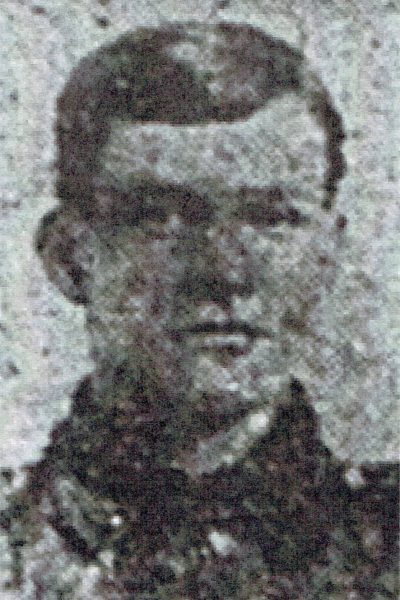
John Edward Smith
Sergeant 200101, 1st/4th Battalion Northumberland Fusiliers (Territorials)
Thomas Smith married Rebecca Hodgson from Allendale and they were blessed with four children, two boys and two girls, all born in Warden. They lived at Frankham Cottages.
Eldest son Joseph Hodgson Smith left Newbrough School in 1902 and worked as a freestone cutterman. At the age of 26 years 9 months he attested on 9th June 1916 with 22nd Northumberland Fusiliers (Territorials). He was transferred as Corporal with York and Lancaster Regiment serving at the Western Front and the Rhine. He was wounded at the notorious Highwood on 15th September 1916. His active service ended on 30th April 1919.
John left Newbrough School in 1907, worked at Fourstones Colliery and was mobilised at the beginning of the war and went to France in April 1915. He served with the “Fusiliers” in all of the heavy battles in which they were engaged. He was wounded on 18th October 1916 and then was reported missing on 27th May 1918.
In January 1919 the Hexham Courant reported that Mrs T Smith had received “word from a returning prisoner, of the death of her youngest son, Sergt. John Edward Smith”. He died, aged 25, of wounds accidentally by a bursting shell whilst a prisoner of war at Amifontaine.
Remembered with Honour Soissons Memorial. Newbrough War Memorial, Newbrough Town Hall Great War Roll of Honour, Newbrough School Memorial Tablet and St Peter’s Church Lychgate. Roll of Honour 4th Northumberland Fusiliers Territorial Army Hexham.
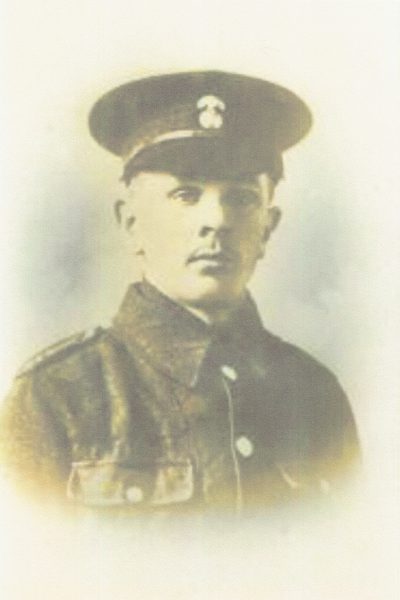
Norman Charlton
Lance Sergeant, 1712, 1st/4th Battalion, Northumberland Fusiliers
Norman, Walter and John Charlton were brothers who all fought in World War One. They were three of the eleven children of George (Squeaker) Charlton and Mary Ann Rowell.
George (their father) was a local man, born at Warden and lived at Frankham Fell until he married and moved to Haydon Bridge, where most, if not all of his (eleven) children were born. [Note – The 1901 & 1911 census records both list the family living at Haydon Bridge, the report in the Hexham Courant in September 1918, reporting Walter’s death, says his parents lived at Frankham Fell, perhaps they moved back to Newbrough].
Both Norman and Walter were killed in the war, John, slightly luckier, lost a leg (Reputed to have been removed on the battlefield by a German surgeon).
Norman, the eldest of the three was a Lance Sergeant in the 1st/4th Battalion, Northumberland Fusiliers, went to France on 20th April 1915. He clearly got leave to return home and married Evelyn Taylor on the 26th August 1916 at Hexham Registry Office. He returned to France and was killed in action at the “Battle of the Somme” on the 15th September 1916. His only child, Evelyn Mary Charlton was born six days later on 21st September 1916. A lot happened in a very short time (less than four weeks) to poor Norman. He has no known grave; his name is inscribed on the Thiepval Memorial at Picardy in France.
Norman’s picture is one of 600 chosen in 2004 to form the “Panel of the Missing” which is displayed in the Thiepval Visitor Centre.
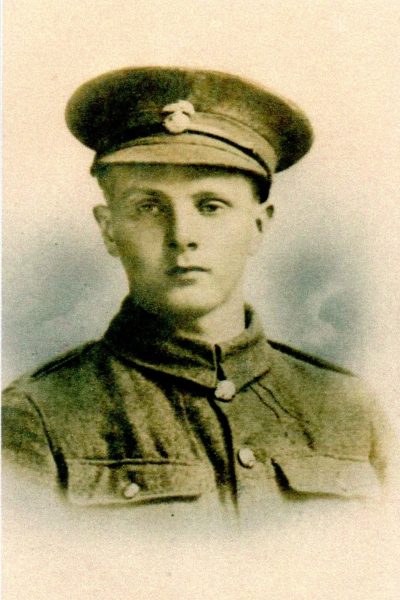
Walter Charlton,
Private 235351, 5th Battalion King's Own Yorkshire Light Infantry
Walter, Norman’s younger brother, joined up in April 1917, originally with the Northumberland Fusiliers (Pte 204688) and then with the Kings Own Yorkshire Light Infantry, was wounded in October 1917 and killed in action on 27th August 1918. This was possibly in the “Battle of Amiens”, which was the final major battle of the war. He was only 21 years old and is buried near Calais in France.
Remembered with Honour H.A.C. Cemetery, Ecoust-St. Mein
John Charlton, the youngest of the three brothers, joined up in the later stages of the war, still in his teens. He lived at “Prudham Stone” (Above Frankham). John wasn’t killed and therefore isn’t listed on any of the memorials.

Matthew James Johnson
Private 60429, 10th Battalion Royal Welsh Fusiliers
Joseph Johnson was born in Warden about 1845, he moved to Medomsley and on 1881 he is living with his wife Catherine and four children; Mary Ann, Margaret E, Catherine J and Matthew James.
Matthew was born in 1880 (Derwent Cottages, Medomsley), left Newbrough Boys’ School in 1894 and was working as a “freestone quarryowner’s“ clerk in 1901. He had his tenth and twentieth birthdays when he lived at Kiln Cottages with his uncle Matthew Davison and close cousin Stephen who both worked at the freestone quarry.
Matthew enlisted at Dumfries and as Private 223817 Army Service Corps., transferred to Private 60429 Infantry Base Depot., then 10th Battalion Royal Welch Fusiliers and then Hood Battalion (10th Battalion Royal Welch Fusiliers attached Hood Battalion) Royal Navy Division. He was killed in action on 1st October 1918. He appointed as executors of his will, John W Moffitt and Stephen Pearson Davison.
Remembered with Honour Vis-En-Artois Memorial, Newbrough School Memorial Tablet and St Peter’s Church Lychgate.
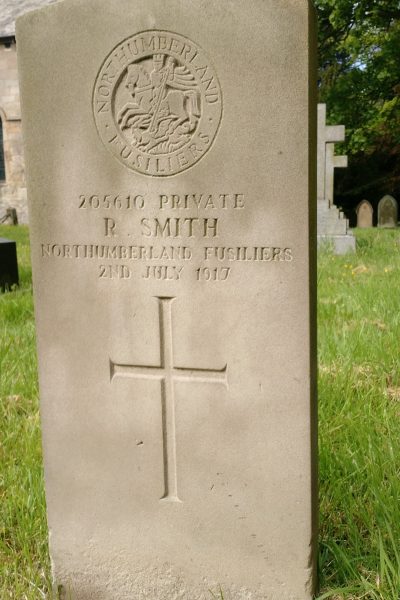
Robert Smith,
Private 205610 1st/4th Battalion Northumberland Fusiliers
The Hexham Courant reports, “Though he sleeps not with his comrades on the stricken field, Pte. Robert Smith, of Hexham rests in a soldier’s grave in the quiet churchyard of Warden.”
The Commonwealth War Graves Commission’s gravestone marks the place of burial of Robert Smith. His funeral took place on 5th July 1917 with semi-military honours; the coffin was covered with a Union Jack. He died at Scotton, Catterick Bridge Hospital three days earlier. Robert was the second youngest of ten children born to Robert and Mary who ended up living in Woodbine Terrace after many years at Nether Warden. Robert was christened on 4th October 1885 at St Michael’s Warden.
Robert worked as a gardener and in 1914 in his 28th year he married Constance Lonsdale (dressmaker from Tow Law) and was the father of a son Allen Lonsdale Smith soon after. He mobilised with Northumberland Fusiliers (Hexham Territorials) in August 1914 and for some time quartered in the Isle of Man. He suffered ill health on returning to Catterick Bridge; he died (aged 31 years) a matter of weeks before he was due to go out to France.
Robert is remembered on the Roll of Honour TA Centre Hexham List of Northumbria’s Gallant Sons.

Thomas Ridley Peart,
Private 29801, 2nd/6th Battalion Royal Warwickshire Regiment
In 1901 Stephenson Peart was a stockman on a farm at Brokenhaugh then the family on next census were at Walwick Fell and father and son were working at the limestone quarry. His wife, Mary Peart (nee Stokoe), had two daughters (Winnie and Alice) and two sons who both saw active service on the Western Front.
Ridley trained at Rugerley Camp with the Royal Warwickshire Regiment. He was reported killed in action at Valenciennes, 24th October 1918 aged 19 years when the Graves Registration Committee contacted the family.
His brother Norman, born 1889 left Newbrough School in 1913. He was a reservist and on joining deemed to be enlisted. On October 19th 1917 he was aged 17yrs 1 month and joined 2nd Training Battalion at Rugely Camp. He was Private 178742 with 9th Battalion Durham Light Infantry in January 1916 then transferred to Machine Gun Corps 92959 until May 1919. He was in action in France in 1918 and received several injuries including wounds at Marne. He was at Rouen and Trouville then transferred from the sick convoy on 3rd January1919 to Military Convalescent Hospital, Eastbourne.
Thomas Ridley Peart is Remembered with Honour Crucifix Cemetery, Vendegies-Sur-Ecaillon, Newbrough War Memorial, Newbrough Town Hall Great War Roll of Honour, Newbrough School Memorial Tablet and St Peter’s Church Lychgate.

Frank Thorburn,
Private 16834, 2nd Battalion Duke of Wellington's (West Riding Regiment)
The Parish Register of Warden St Michael on July 25th 1897 shows the baptism of Frank Thorburn, son of Frank and Mary Ann (nee Smith) of Frankham Cottages. The Thorburns had been at Frankham since at least the 1840s. Father Frank was a breaksman at the quarry with nine children.
Mrs F Thorburn received word from the British Red Cross Society that her son Thomas (4th Battalion Northumberland Fusiliers) missing since May 27th was now a Prisoner of War. He was to remain so for eight months. Before the war he was a horse driver in the lime quarry.
Youngest son Andrew’s attestation was dated 26th June 1918 as Private 104531 with 5th Durham Light Infantry Home Service. He left Newbrough School in 1913 and worked as a quarry breaksman before the war.
William a Private King’s Own Yorkshire Light Infantry was wounded at the Front on 11th May 1917. He was baptised at St Peter’s on 5th January 1890 and left Newbrough School in 1903.
Frank’s Attestation on 19th January 1916 at Hexham describes him as a shop porter aged 18 years 7 months. He was with the 4th Battalion Northumberland Fusiliers. On 29th June 1916 he moved to the 2nd Battalion Duke of Wellington’s (West Riding of Yorkshire), and on 10th February 1918 he transferred to the 10th Brigade in the same Division.
The Duke of Wellington’s were engaged in the Final Advance in Picardy, more particularly the Battle of the Selle, 17th to 25th October 1918. This has been described as the hardest-fought of the final offensive actions. First, Third and Fourth Armies exploited their success in breaking the Hindenburg Line by pushing on across the Rivers Selle and Sambre, recapturing Valenciennes and finally in liberating Mons – where it had all begun for the British Expeditionary Force more than four years earlier.
Frank was reported killed in action in France on 24th October 1918
Remembered with Honour Verchain British Cemetery, Verchain-Maugre, Newbrough War Memorial, Newbrough Town Hall Great War Roll of Honour, Newbrough School Memorial Tablet and St Peter’s Church Lychgate.
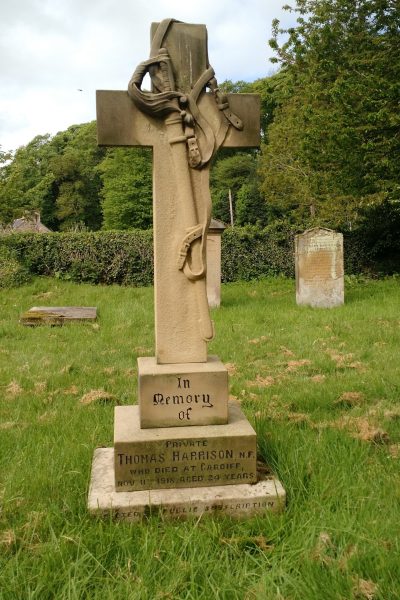
Thomas Harrison
Private 39254, 4th Battalion Lancashire Fusiliers
Thomas was a son of Joseph and Elizabeth Harrison, of Railway Cottage, Warden. His father was a railway platelayer and when Thomas left school he worked at the Paper Mill bleaching house. The family, with children Mary, Thomas, Elizabeth and Joseph, lived at Greenshaw Plain, West Wood before moving to Warden by 1911.
When he was just 17 years old, Thomas signed up to Territorial Force (6th Battalion Northumberland Fusiliers) on 24th April 1912; for four year’s Service. He was working for the Settlingstone’s Mining Company at the time.
Thomas Harrison Private 11961 6th Battalion Northumberland Fusiliers transferred to 21st Battalion Northumberland Fusiliers (Private 43736), then finally Private 39254, 4th Battalion Lancashire Fusiliers.
The Hexham Courant of 20th April 1918 records that Thomas had been gassed earlier in April and that he was in hospital in Kent. He was seriously ill, suffering from pneumonia and died in the Albany Hospital, Cardiff on 11th November 1918
Thomas is buried in Warden (St. Michael) Churchyard and Remembered on Newbrough War Memorial, Newbrough Town Hall Great War Roll of Honour and St Peter’s Church Lychgate. An Inscription on a Cupboard at St Michael and All Saints’ Church Warden remembers his sacrifice.
Harold Brown Hetherington,
Serjeant 36971, No. 1 Cadet Battalion. (Newark), Royal Engineers
Harold was born on 30th January 1886 and christened on 21st March at the Wesleyan Chapel Hexham; the seventh of nine children. His father was John Westgarth Hetherington and mother, Sarah Ann (nee Brown). They lived at Frankham House and his father John was work’s manager at the Freestone and Limestone Quarries.
The 1911 census records Harold being employed as a marine draughtsman. He enlisted and sailed to Egypt on 21st November 1915 with 136th Army Troops Company. He was entitled to the Victory Medal and the British War Medal and 15 Star. He died of pneumonia in hospital at Newark and Sherwood District, on 30th November 1918 aged 32.
Remembered In Memoriam on a freestone monument and kerb at Hexham (St. Andrews) Cemetery; he is also remembered on Newbrough War Memorial, Newbrough Town Hall Great War Roll of Honour and St Peter’s Church Lychgate.
Ernest Edwin Elliott,
Private 469, 4th Battalion Northumberland Fusiliers
In August 1893 Ernest Edwin, son of Elizabeth and Robert Elliott, pitman of Red Houses was baptised at St Peter’s Church Newbrough; he is also buried there. He was a pupil at Newbrough School and left in 1907. Ernest Elliott, Pte 469 arrived in France on 21st April 1915 serving with 4th Battalion Northumberland Fusiliers. He was listed as “Wounded” on the Casualty List issued by the War Office from the 24th February 1916 and as such was entitled to wear a “Wound Stripe” as authorised under Army Order 204 of 6th July 1916. His regiment at the time was in the Ypres Salient between the Menin Road and Hill 60. (The latter was the name given by veterans to a hill in Hexham).
On 28th August 1918 he was transferred to 13th Battalion Royal Fusiliers 279424, 3rd (City of London) Battalion Royal Fusiliers.
Ernest died, at the age of 26 years, of pneumonia after demobilisation. He was entitled to Victory Medal and British War Medal and 15 Star.
He is remembered on Newbrough Town Hall Great War Roll of Honour (originally displayed at Newbrough Church of England Boys’ School).
Roll of Honour Territorial Army Centre Hexham List of Northumbria’s Gallant Sons

